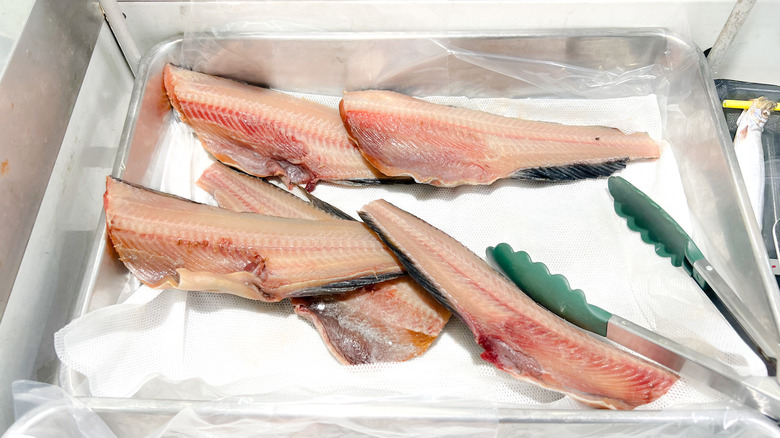How To Store Fresh Fish In The Fridge
We may receive a commission on purchases made from links.
For lovers of seafood, there's no greater delight than purchasing fresh fish. Whether it's already fileted or you're getting ready to eat a whole fish like a true food connoisseur, you'll just need to figure out storage until cooking time finally arrives. Unfortunately, fish is delicate, so it'll need a bit more special treatment than simply stowing away in the fridge.
Even at a typical refrigerator temperature just under 40 degrees Fahrenheit, your marine purchase will start to degrade after a day. Yet, at the same time, you won't want to throw that fresh catch into the freezer. So, for the ideal storage temperature, combine the best of both worlds by keeping the seafood on ice in the fridge. Such a storage technique will maintain the fish at nearly exactly 32 degrees Fahrenheit, extending its freshness to a few days without diminishing its quality.
For both food safety and smell, it's critical to get the fish as clean as possible, though. So, whenever you get home from shopping for seafood, clean your purchase as needed and pat it dry so any lingering moisture doesn't speed up spoilage. Then, using the following tips, layer the whole fish or fillets over ice in single layers, keeping them cool and fresh for longer.
Keep fish cold over ice in the fridge
Cooking delicious fish is all about freshness, so the quality control starts while you're still shopping. One of the biggest mistakes while buying seafood is not selecting fresh products, so make sure to purchase with care. A useful indicator is the presence of clean ice underneath fish at the market counter. To ensure there's minimal deterioration, keep the seafood at cold temperatures from this moment onwards, even if it means bringing a cooler to the grocery store.
Once you've gotten home, continue to minimize the time that seafood spends exposed to warm air. Keep in mind that fish naturally inhabit cold waters, so even a slightly cool ambient environment is still enough to inspire degradation. Quickly clean and dry the fish, then get your fridge storage setup ready. You'll need to clear enough space in the fridge, especially if you've purchased a large quantity of seafood.
Start by packing baking sheets with crushed ice, then place either a cooling rack, another pan, or the fish packed in sealable Ziploc freezer bags over the ice. Wrap the entire grocery haul in plastic wrap or aluminum foil. Whichever method you employ, just make sure fish isn't coming into direct contact with the ice and there's limited exposure to air. Store it in the back of the fridge, intermittently checking for any melted ice. With such care in mind, you'll be able to grill a show-stopping fish dinner later that week without spoilage concerns.

